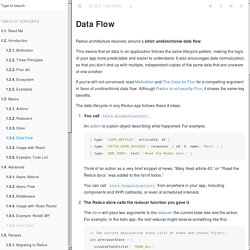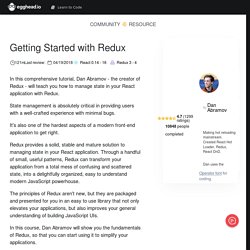

Dissecting Twitter’s Redux Store – Statuscode – Medium. If you don’t already know Twitter’s mobile website is on a new web stack which includes React and Redux 🎉.

After hearing the news I thought it would be fun to dig into their Redux store, and see how in the hell they organize all them tweets in their state tree. NOTE: All observations are from me poking around in Chrome devtools and are at best educated guesses onto what’s happening in the app. To get a look at the Redux store you will need React Developer Tools (RDT) installed for Chrome. Then from the RDT tab select the root element of the application and type the following in your console. // $r is a shortcut that references the selected element in RDT$r.store.getState(); Thanks Wes Bos for tweeting out the tip on the above. You should see the Redux state tree logged to the console like this… I recommend taking the time to poke around all the different state slices, but I’m going to be digging into entities/tweets and homeTimeline. That’s all I got for now… Learn Redux Video Tutorial Course. Markerikson/react-redux-links: Curated tutorial and resource links I've collected on React, Redux, ES6, and more.
10 Tips for Better Redux Architecture – JavaScript Scene – Medium. When I started using React, there was no Redux.

There was only the Flux architecture, and about a dozen competing implementations of it. Now there are two clear winners for data management in React: Redux and MobX, and the latter isn’t even a Flux implementation. Redux has caught on so much that it’s not just being used for React anymore. You can find Redux architecture implementations for other frameworks, including Angular 2.
See ngrx:store, for example. Side note: MobX is cool, and I’d probably choose it over Redux for simple UIs, because it’s less complicated and less verbose. Side side note: Relay and Falcor are other interesting solutions for state management, but unlike Redux and MobX, they must be backed by GraphQL and Falcor Server, respectively, and all Relay state corresponds to some server-persisted data.
Dan Abramov, the creator of Redux made a couple great courses on the topic: The following are tips that will help you build better Redux apps. GitHub - joshwcomeau/redux-sounds: Middleware for playing audio / sound effects using Howler.js. Redux/WritingTests.md at master · reactjs/redux. React-redux-pract/app.js at redux · mandy-kate/react-redux-pract. GitHub - StephenGrider/ReduxSimpleStarter: Starter pack for an awesome Udemy course.
Data Flow · Redux. Redux architecture revolves around a strict unidirectional data flow.

This means that all data in an application follows the same lifecycle pattern, making the logic of your app more predictable and easier to understand. It also encourages data normalization, so that you don't end up with multiple, independent copies of the same data that are unaware of one another. Learn Redux Video Tutorial Course. Getting Started with Redux - Course by @dan_abramov. In this comprehensive tutorial, Dan Abramov - the creator of Redux - will teach you how to manage state in your React application with Redux.

State management is absolutely critical in providing users with a well-crafted experience with minimal bugs. It's also one of the hardest aspects of a modern front-end application to get right. Redux provides a solid, stable and mature solution to managing state in your React application. Through a handful of small, useful patterns, Redux can transform your application from a total mess of confusing and scattered state, into a delightfully organized, easy to understand modern JavaScript powerhouse. The principles of Redux aren't new, but they are packaged and presented for you in an easy to use library that not only elevates your applications, but also improves your general understanding of building JavaScript UIs. In this course, Dan Abramov will show you the fundamentals of Redux, so that you can start using it to simplify your applications. Redux Tutorial #1 - React js tutorial - How Redux Works. 10 Tips for Better Redux Architecture – JavaScript Scene – Medium.
When I started using React, there was no Redux.

There was only the Flux architecture, and about a dozen competing implementations of it. Now there are two clear winners for data management in React: Redux and MobX, and the latter isn’t even a Flux implementation. Redux has caught on so much that it’s not just being used for React anymore. You can find Redux architecture implementations for other frameworks, including Angular 2.
See ngrx:store, for example. Side note: MobX is cool, and I’d probably choose it over Redux for simple UIs, because it’s less complicated and less verbose. Side side note: Relay and Falcor are other interesting solutions for state management, but unlike Redux and MobX, they must be backed by GraphQL and Falcor Server, respectively, and all Relay state corresponds to some server-persisted data.
Dan Abramov, the creator of Redux made a couple great courses on the topic: The following are tips that will help you build better Redux apps. 1. 2. Redux/products.js at master · reactjs/redux.